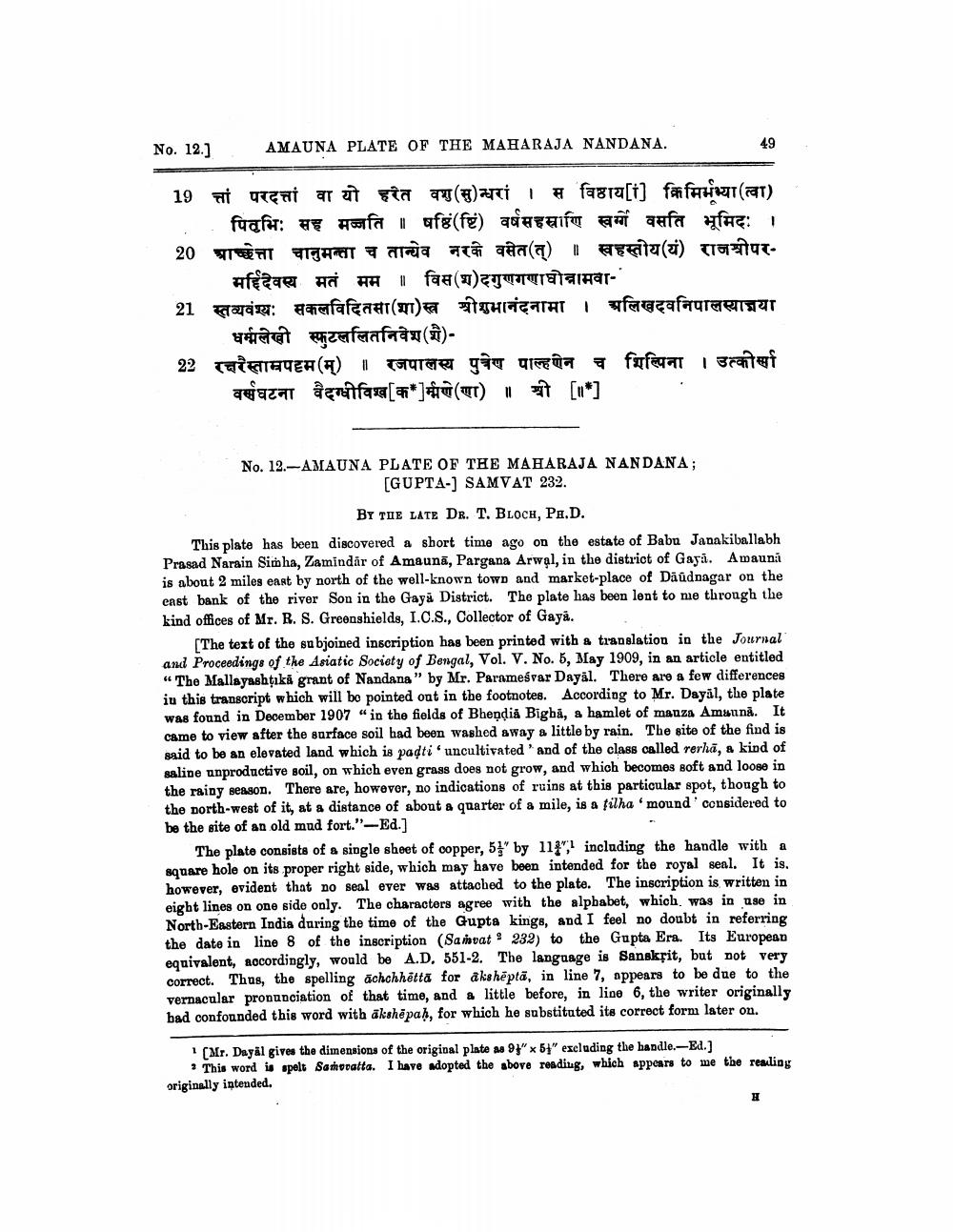________________
AMAUNA PLATE OF THE MAHARAJA NANDANA.
No. 12.]
19 तां परदत्तां वा यो हरेत वश (सु) न्धरां । स विष्ठाय[]] क्रिमिभ्या (त्वा) पितृभिः सह मण्णति । षष्टिं (ष्टिं वर्षसहस्राणि स्वर्गे वसति भूमिदः । 20 पाता चानुमन्ता च तान्येव नरके वसेत (त्) । वहस्तीय (यं) राजश्रीपरमर्हिदेवस्य मतं मम ॥ विस (श) दगुणगणाधीनामवा
21 स्तव्याः सकलविदितसा (मा) व श्रीरामानंदनामा । अलिखदवनिपालस्याज्ञया
स्त्र
49
धर्मलेखी स्फुटललितनिवेश (शै)
22 रचरैस्ताम्रपट्टम (म्) ॥ रजपालस्य पुत्रेण पाल्हणेन च शिल्पिना । उत्कीर्खा घटना वैदग्धीविध[क] मीणा ॥ श्री [*]
No. 12.-AMAUNA PLATE OF THE MAHARAJA NANDANA;
[GUPTA-] SAMVAT 232.
BY THE LATE DR. T. BLOCH, PH.D.
This plate has been discovered a short time ago on the estate of Babu Janakiballabh Prasad Narain Simha, Zamindar of Amauna, Pargana Arwal, in the district of Gaya. Amaunā is about 2 miles east by north of the well-known town and market-place of Daudnagar on the east bank of the river Son in the Gaya District. The plate has been lent to me through the kind offices of Mr. R. S. Greenshields, I.C.S., Collector of Gaya.
[The text of the subjoined inscription has been printed with a translation in the Journal and Proceedings of the Asiatic Society of Bengal, Vol. V. No. 5, May 1909, in an article entitled "The Mallayashṭika grant of Nandana" by Mr. Paramesvar Dayal. There are a few differences in this transcript which will be pointed out in the footnotes. According to Mr. Dayal, the plate was found in December 1907 "in the fields of Bhendia Bigha, a hamlet of manza Amaunā. It came to view after the surface soil had been washed away a little by rain. The site of the find is said to be an elevated land which is paḍtiuncultivated and of the class called rerha, a kind of saline unproductive soil, on which even grass does not grow, and which becomes soft and loose in the rainy season. There are, however, no indications of ruins at this particular spot, though to the north-west of it, at a distance of about a quarter of a mile, is a filha 'mound' considered to be the site of an old mud fort."-Ed.]
The plate consists of a single sheet of copper, 5" by 11" including the handle with a square hole on its proper right side, which may have been intended for the royal seal. It is. however, evident that no seal ever was attached to the plate. The inscription is written in eight lines on one side only. The characters agree with the alphabet, which was in use in North-Eastern India during the time of the Gupta kings, and I feel no doubt in referring the date in line 8 of the inscription (Samvat 232) to the Gupta Era. Its European equivalent, accordingly, would be A.D. 551-2. The language is Sanskrit, but not very correct. Thus, the spelling achchhettä for akshēpta, in line 7, appears to be due to the vernacular pronunciation of that time, and a little before, in line 6, the writer originally had confounded this word with akshepaḥ, for which he substituted its correct form later on.
2
1 [Mr. Dayal gives the dimensions of the original plate as 93" x 5" excluding the handle.-Ed.]
This word is spelt Samevatta. I have adopted the above reading, which appears to me the reading originally intended.
H




